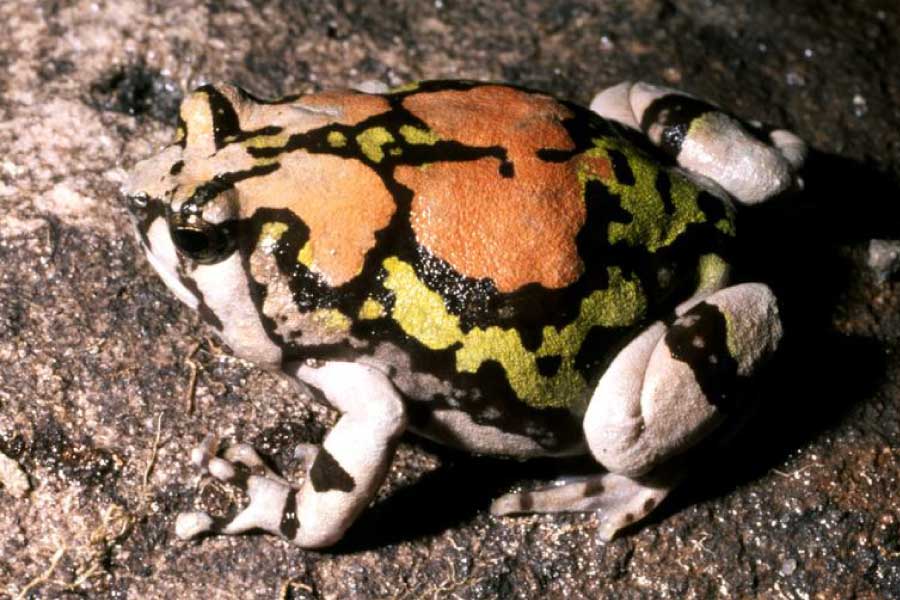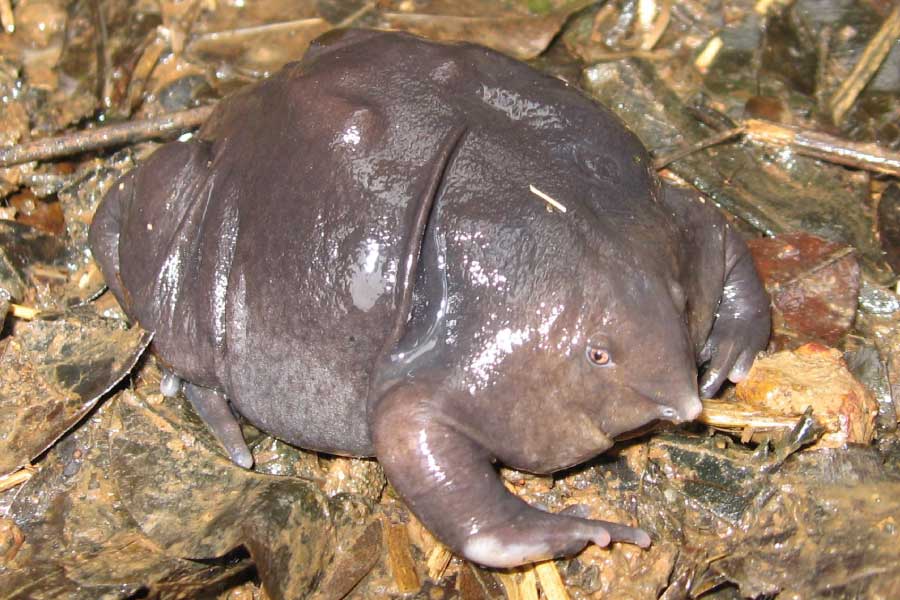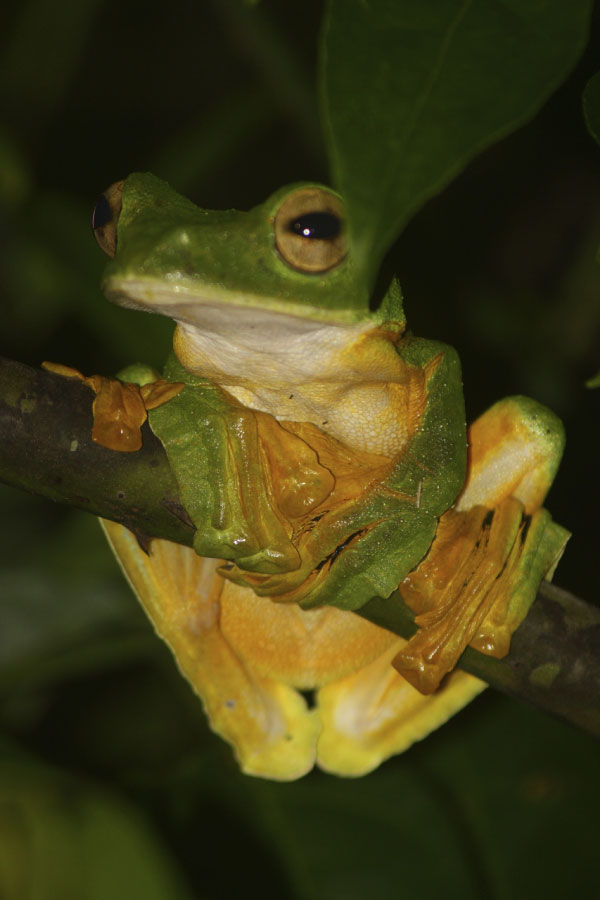Examples of weird amphibians include the Chinese giant salamander, the world’s largest amphibian; amphiumas, a group of eel-like salamanders with tiny legs; the African clawed toad, which has bizarre clawed hind feet; the olm, a blind, cave-dwelling salamander; and Wallace’s flying frog, which is able to glide with its webbed feet.
On this page, you’ll meet all of these, and many other weird amphibians, from all around the world.
Have you seen any of these species? What’s your favorite? Are there any weird amphibians we’ve missed out? Let us know in the comments section at the bottom of the page!
Weird Amphibians
You can see more weird species on the following pages:
Weird Animals Pictures & Facts
Weird Birds Pictures & Facts
Weird Fish Pictures & Facts
Weird Insects Pictures & Facts
Weird Mammals Pictures & Facts
Weird Reptiles Pictures & Facts
Weird Sea Creatures Pictures & Facts
Weird Plants Pictures & Facts
Ugly Animals Pictures & Facts
Discover More About Animals
Discover More About Amphibians
Amphibians – The Ultimate Guide
Amphiumas
Scientific name: Amphiuma spp.

Family: Amphiumidae
Continent: North America
IUCN conservation status: See text
Native to the southeastern United States, amphiumas are eel-like salamanders with tiny, vestigial limbs. They are carnivorous, feeding on small aquatic animals. The three species of amphiumas are listed below. As their names suggest, the species are differentiated by the number of toes they have.
- Three-toed amphiuma – Amphiuma tridactylum – Least Concern
- Two-toed amphiuma – Amphiuma means – Least Concern
- One-toed amphiuma – Amphiuma pholeter – Near Threatened
Axolotl

Scientific name: Ambystoma mexicanum
Family: Ambystomatidae
Continent: North America (specifically, Mexico)
IUCN conservation status: Critically Endangered
Found only in Mexico, axolotls are salamanders that exhibit neoteny, retaining their larval features and remaining aquatic throughout their lives (most amphibians undergo metamorphosis and often live on land as adults). Axolotls are carnivorous, feeding on small aquatic animals. Although critically endangered in the wild, these weird amphibians are popular pets.
African Clawed Frog

Scientific name: Xenopus laevis
Family: Pipidae
Continent: Africa
IUCN conservation status: Least Concern
African clawed frogs have distinctively clawed hind feet and flattened bodies. They use their claws to tear food apart and to protect themselves against predators. These weird frogs are fully aquatic and feed on a variety of invertebrates and small fish.
Common Midwife Toad

Scientific name: Alytes obstetricans
Family: Alytidae
Continent: Europe
IUCN conservation status: Least Concern
Found in Europe, these toads are known for their unusual reproductive behavior, in which the male carries the fertilized eggs wrapped around his hind legs. They feed on insects and other small invertebrates.
Gardiner’s Seychelles Frog

Scientific name: Sechellophryne gardineri
Family: Sooglossidae
Continent: Africa (specifically, Seychelles)
IUCN conservation status: Endangered
This tiny frog measures just 1 cm in length and is one of the world’s smallest frogs. The species is native to the Seychelles (an island country located in the Indian Ocean). It feeds on small insects and other invertebrates.
Giant Salamanders

Scientific name: Andrias japonicus (Japanese Giant Salamander); Andrias davidianus (Chinese Giant Salamander)
Family: Cryptobranchidae
Continent: Asia
IUCN conservation status: Critically Endangered (Chinese) and Near Threatened (Japanese)
Giant salamanders are the world’s largest living amphibians, with some species reaching lengths of over 1.5 meters / 4.92 ft. They are aquatic and feed on fish, crustaceans, and other small aquatic animals. Two species are traditionally recognized: The Japanese and Chinese giant salamanders. However, it is now thought that there are at least two giant salamander species in China.
Hellbender

Scientific name: Cryptobranchus alleganiensis
Family: Cryptobranchidae
Continent: North America
IUCN conservation status: Vulnerable
Found in the eastern United States, the hellbender is a large, fully aquatic salamander. It has a flattened body and feeds on crayfish, fish, and other aquatic creatures. Reaching lengths of up to 74 cm / 29 in., the hellbender is the largest amphibian found in North America. Although this strange amphibian does have lungs, it obtains most of the oxygen it needs via its heavily wrinkled skin.
Malagasy Rainbow Frog

Scientific name: Scaphiophryne gottlebei
Family: Microhylidae
Continent: Africa (specifically, Madagascar)
IUCN conservation status: Endangered
Native to the African island-country of Madagascar, this brightly-colored frog is known for its striking red and yellow patterning. It is primarily terrestrial and feeds on insects and other invertebrates.
Mexican Burrowing Toad

Scientific name: Rhinophrynus dorsalis
Family: Rhinophrynidae
Continent: North America (specifically, Mexico) and Central America
IUCN conservation status: Least Concern
The Mexican burrowing toad is a fossorial (burrowing) species with a specialized, shovel-like snout for digging. Its body is almost as wide as it is long. This weird amphibian feeds mainly on ants and termites. It is found in Mexico and Central America.
Motorbike Frog

Scientific name: Litoria moorei
Family: Hylidae
Continent: Australia
IUCN conservation status: Least Concern
Native to Australia, this frog is named for its distinctive call, which sounds like a revving motorcycle. It inhabits a variety of habitats and feeds on insects and other small invertebrates. Despite being a member of the “tree frog” family, Hylidae, the motorbike frog is rarely found far from the ground.
Olm

Scientific name: Proteus anguinus
Family: Proteidae
Continent: Europe
IUCN conservation status: Vulnerable
This European cave-dwelling salamander is completely blind and has a pale, translucent skin. It is adapted to a life in darkness and feeds on small aquatic invertebrates. This weird amphibian is entirely aquatic, never leaving the water. Like the axolotl, it does not undergo metamorphosis.
Purple Frog

Scientific name: Nasikabatrachus sahyadrensis
Family: Sooglossidae
Continent: Asia (specifically, India)
IUCN conservation status: Near Threatened
Native to India, this frog has a bizarre, rounded body and a purple-blue coloration. It is a burrowing species and feeds primarily on termites.
Surinam Horned Frog

Scientific name: Ceratophrys cornuta
Family: Ceratophryidae
Continent: South America
IUCN conservation status: Least Concern
The Surinam horned frog, also known as the Amazonian horned frog, is named for the horn-like projections above its eyes. This weird-looking amphibian is an ambush predator, feeding on insects, small mammals, and other amphibians. Its tadpoles are aggressive, attacking each other and tadpoles of other species.
Tomato Frog

Scientific name: Dyscophus spp.
Family: Microhylidae
Continent: Africa (specifically, Madagascar)
IUCN conservation status: Varies by species
Native to the African island-country Madagascar, tomato frogs are known for their bright red or orange coloration, resembling a tomato. They are terrestrial and feed on insects and other small invertebrates.
Wallace’s Flying Frog

Scientific name: Rhacophorus nigropalmatus
Family: Rhacophoridae
Continent: Asia (Southeast Asia)
IUCN conservation status: Least Concern
This Southeast Asian frog is named after the naturalist Alfred Russel Wallace. It has large, webbed feet that allow it to glide between trees and feeds mainly on insects and other small invertebrates.
Discover More With Active Wild
You can see more weird species on this page: Weird Animals Pictures & Facts

